Shoulder Pain
Have you experienced shoulder pain? Maybe you felt a ‘pinch’ after taking up a new exercise activity or after waking up from an uncomfortable sleeping position. Your shoulder is the joint that connects the arm to the upper torso. We use our shoulders daily to perform activities that are part of our regular routine.
When we do experience shoulder pain, it can be a difficult thing to ignore or continue working with. There are many structures in and around the shoulder that can become injured. Therefore, to understand shoulder pain, we need to know how the shoulder functions and works in the human body.
Common Shoulder Pain and Injuries Seen at Our Edmonton Chiropractic and Physiotherapy Clinic:
- Rotator cuff injuries
- Shoulder Impingement
- Frozen shoulder
- Bursitis
- Thoracic outlet syndrome
- Sprains/strains
- Tendinitis
- Cervical radiculopathy
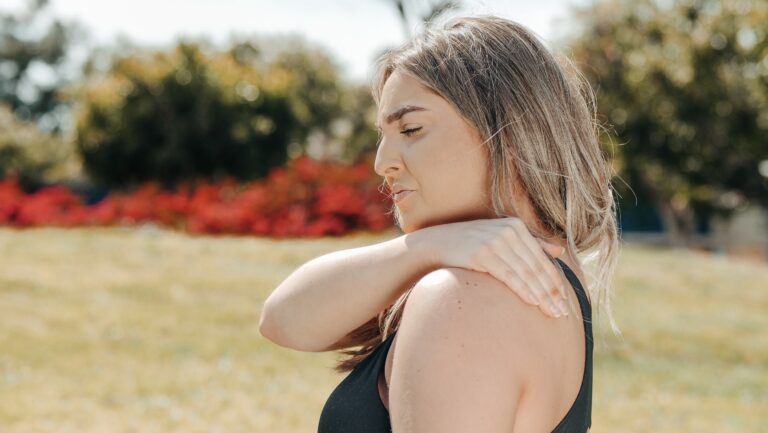
Shoulder pain can be a result of overusing the shoulder while playing sports or experiencing major trauma like a fall or even from an issue coming from your neck. At times, shoulder pain may not actually be caused from a shoulder injury but rather an issue in your neck can refer pain into your shoulder or arm.
Knowing when and how you started having shoulder pain will provide your practitioner with a better understanding of the structures involved. Your ability or inability to perform certain functional tasks will also help to pinpoint which structures are the root cause of the pain and which areas are compensating.
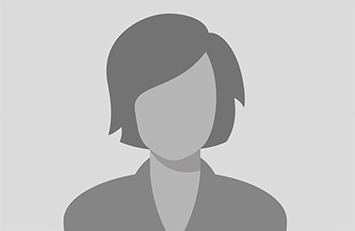
What Is The Shoulder?
The shoulder is a complex structure that involves several bones, ligaments, cartilage, a number of muscles, fluid-filled sacs designed to absorb forces, and the joint itself. When one or more of these structures become injured, the abilities of the shoulder are affected significantly.
The shoulder complex is considered a ‘ball-and-socket’ joint. This means that the bony ‘ball’ of the humerus (the head of the upper arm bone) is nestled in a bowl-like shape of the scapula (shoulder blade). The bowl-like shape is considered the ‘socket’ of the joint and is also known as the glenoid fossa.
Together, this is known as the ‘glenohumeral joint’ and is kept in place via a suction cup mechanism created by the labrum. The labrum is a cartilaginous rim that surrounds the joint.
There are other bones that and joints that make up and contribute to the function of the shoulder including the clavicle (collarbone), which connects to the sternum creating the ‘SC joint’ (sternoclavicular) and the acromion which is a part of the scapula creating the ‘AC joint’ (acromioclavicular).
That is the bare bones of the shoulder complex, but what about the muscles? There are over a dozen different muscles that contribute to health shoulder function and movement. The primary muscles of the shoulder that you may have heard of are known as the rotator cuff.
The rotator cuff muscles not only aid in function and range of motion of the shoulder, they also provide stability. These are:
- Supraspinatus
- Infraspinatus
- Teres Minor
- Subscapularis
Aside from the rotator cuff muscles, there are other muscles that attach to the scapula, spine, ribs, and humerus that are recruited for assistance:
- Trapezius: a thick muscle that spans along the spine of the back and the neck and to the shoulder
- Serratus Anterior: attaches from the ribs to the underside of the scapula and helps in motions such as throwing a punch
- Deltoid: a triangular shaped muscle that located at the glenohumeral joint and is what most people think of when they mention the shoulder
- Pectoralis Major: the primary chest muscle that connects to the sternum, collarbone, and humerus
- Rhomboid Major: a muscle of the back that connects the spine to the scapula
There are other supportive muscles that attach to the shoulder complex including the biceps, latissimus dorsi (lats), pec minor, and tricep. There are also supportive ligaments, bursae (fluid-filled sac), and the actual joint capsule itself.
As you can see, the shoulder is a complex structure with many components that work together to allow flexibility, stability, and movement to perform various activities. In fact, the shoulder complex is the most mobile joint in the human body! Needless to say, shoulder pain isn’t always straightforward.

Where does shoulder pain come from?
After going through the anatomy of the shoulder, it is apparent that shoulder pain is not ‘one size fits all’. Shoulder pain can stem from the joint itself or from the surrounding structures including the labrum, muscles, and even the neck.
In fact, shoulder pain may arise from an organ inside the body which refers pain to the shoulder! Pain that is caused from somewhere else in the body is known as referred pain.
Not all shoulder pain is felt equally, therefore knowing the cause and the type of shoulder pain is important to properly treat the underlying issue. Common causes of shoulder pain include repetitive motion, such as painting, and traumatic occurrences like falling on an outstretched arm.
Another cause of shoulder pain may actually be from the neck. Sometimes we may feel pain in the shoulder and after doing testing or imaging of the shoulder, there is no identifiable cause in the actual shoulder. This can occur when the source of the pain is coming somewhere else such as nerves from the neck or possibly from internal organs referring pain known as ‘viscerosomatic’ pain.
Shoulder injuries can be caused from:
- Age-related degeneration
- Repetitive overuse
- Trauma – a fall, car accident, or hit to the shoulder
- Poor posture
- Extended use of the shoulder overhead
Other causes of shoulder pain include:
- Autoimmune disease
- Bone spurs
- Broken arm
- Broken collarbone
- Heart attack
- Osteoarthritis
- Referred pain
Rotator Cuff Injuries
The rotator cuff is the most common shoulder complaint that our practitioners treat at Enhanced Health & Wellness. As mentioned above, the rotator cuff consists of 4 muscles for range of motion, function, and stability.
As we use the shoulder for various activities, we begin to accumulate stress over time. Shoulder pain from the rotator cuff begin to occur for 2 primary reasons: a sudden force through the shoulder girdle can lead to a rotator cuff injury as well as repetitive use of the shoulder over time will cause muscles and tendons to become inflamed.
When addressing shoulder pain, in most cases the rotator cuff will be affected in one way or another. Since the rotator cuff muscles are the main muscles responsible for shoulder function, it’s not surprising that one of the muscles in the rotator cuff will be affected when we experience shoulder pain.
Some causes of shoulder pain that involve the rotator cuff include:
- Bursitis
- Cartilage tears
- Dislocated shoulder
- Frozen shoulder
- Impingement
- Muscle strain
- Muscle tears
- Tendinitis
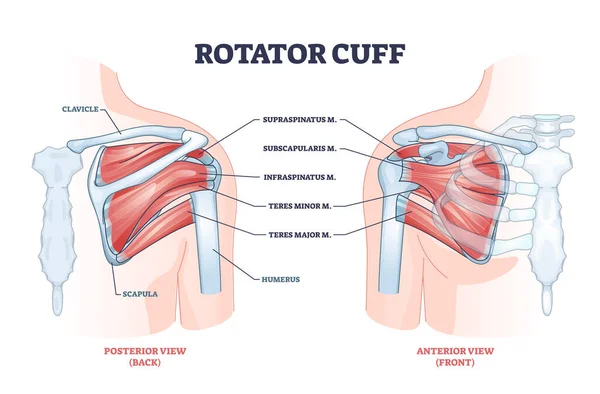
Shoulder Impingement
Shoulder Impingement is a condition that refers to a ‘pinching’ of a muscular tendon within the shoulder. The most common muscular tendon that is affected by shoulder impingement is the supraspinatus muscle. However, other muscles may be impinged such as the long head of the biceps tendon.
Shoulder Impingement can be caused by:
- Degeneration of specific joints
- Scapular dyskinesis
- Thickened coracoacromial ligament
- Poor posture
When looking at the anatomy of the shoulder, the supraspinatus muscle is located on the ‘back of the shoulder’ with the tendon attaching onto the ‘front of the shoulder’. To reach the attachment point on the head of the humerus, the muscle travels between specific bony structures.
If the gap between the structures is decreased, then the muscle/tendon will become ‘impinged’. Degeneration of the acromioclavicular (AC) joint as well as thickening of the coracoacromial ligament can reduce this space.
Scapular dyskinesis refers to improper movement of the scapula which can lead to improper positioning of the glenohumeral joint. Whereas poor posture, such as an upper crossed syndrome (UCS), positions our shoulder into an unfavourable position for efficient movement causing impingement.
Most patients suffering from a shoulder impingement won’t feel pain in the shoulder at rest or using their arm at body level. Impingement begins to occur as we lift our shoulder to perform shoulder level tasks or higher. This pain may cause a patient to limit their activity overhead or laying on the shoulder.

Frozen Shoulder
Frozen shoulder in medical terms is known as adhesive capsulitis. The feeling of the shoulder feeling ‘stuck’ and you can’t move it past a certain spot. Most people will feel a deep, gnawing type of pain with possible sharp stabs if they are trying to push their range of motion.
Frozen shoulder is typically categorized into 3 different phases:
- Initial phase – pain occurs and range of motion starts to become more limited
- Frozen phase – this phase is characterized by stiffness in the joint and the inability to move the shoulder
- Thawing phase – the shoulder begins to return to its original state and range of motion increases
Based on the current research there are some theories of what causes frozen shoulder, however, the cause of frozen shoulder is still unknown. The phases of frozen shoulder can each take months to recover from without proper treatment.
Bursitis
Located at different joints in the body, there are fluid-filled sacs known as bursa. The bursa can be found next to the tendons near the joint. These bursae act as a cushion and allows better movement/gliding of the muscles, ligaments, and bones by decreasing friction.
When a bursa becomes irritated, possibly from a muscular tendon rubbing up against the bursa, it becomes inflamed and is now known as a bursitis. Bursitis will create local pain that will be triggered by direct pressure to the area or by constant irritation of the bursa through a range of motion of the shoulder or specific repetitive activity.
Oftentimes a bursitis can be considered a ‘secondary diagnosis’. This means that a bursitis is a result of some other dysfunction going on in the shoulder.
Shoulder Dysfunction That Can Lead to Bursitis:
- Muscular Imbalances
- Biomechanical Compensation
- Impingement
- Tendinitis
When treating a bursitis, it is important to assess and correct other dysfunction that may be present in and around the shoulder. Without correcting the other underlying issues, there is a greater chance that the bursa can flare up again in the future.
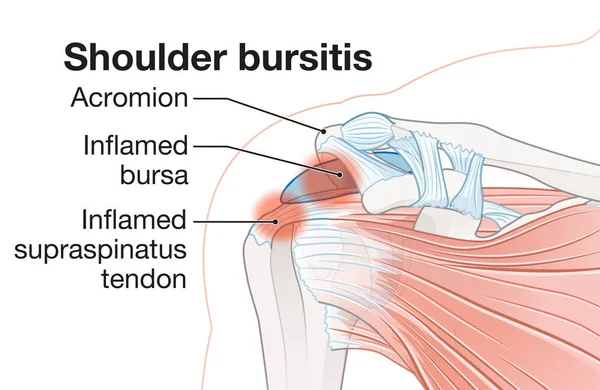
Thoracic Outlet Syndrome
The thoracic outlet is a small area located between the neck and the shoulder that is surrounded by the trapezius muscle and the collarbone. Within the thoracic outlet is brachial plexus. The brachial plexus is a bundle of nerves that come from the neck runs into the shoulder, arm, and hand.
Thoracic outlet syndrome (TOS) describes a series of conditions that cause compression of the major nerves and/or blood vessels within the thoracic outlet. Two types of TOS can occur, neurogenic and vascular, with the neurogenic type being the most common. Approximately 90% of TOS is neurogenic in nature.
Causes of TOS include:
- The presence of a cervical rib
- Tight scalene muscle
- Tight pectoralis minor muscle
- Poor posture
- Repetitive extreme motions of the shoulder – excessive swimming or throwing
If you are experiencing symptoms of thoracic outlet syndrome, a proper assessment is necessary to first determine the type of TOS you are suffering from. Next it is important to determine the underlying cause of the TOS in order to treat and correct the dysfunction causing the TOS.
Sprains/Strains
Both strains and sprains are categorized based on their severity. However, recovery times for strains are generally faster than sprains. A strain of the muscle is commonly known as a ‘pulled muscle’ which involves various degrees of tears in the affected muscle. A sprain involves an over stretch or tear of the ligament depending on the severity
Strain/sprains can happen from something traumatic like falling on the shoulder, overreaching and bringing the muscles or joints past their end range, or from overworking the muscle/joint. Listed below are the different Grades of strains and their general recovery time:
Sprains
- Grade I: The affected area will probably feel sore and be tender to touch. There typically isn’t much swelling or physical discolouration/bruising. Recovery time is approximately 2-4 weeks.
- Grade II: The affected area will be painful and tender when stressing it as well as through range of motion. Swelling and bruising is common. The ligament affected has been overstretched, possibly creating a partial tear. Recovery time is approximately 6-8 weeks.
- Grade III: The affected ligament has completely torn. You shouldn’t be able to load it or go through a full range of motion and there should be severe pain, swelling, and bruising. With proper immobilization of the joint in the beginning as well as proper rehab, recovery time is approximately 3 months to 1 year+. Surgical repair is an option for treatment of this type of sprain
Strains
- Grade I: The muscle has been overstretched with some micro tears of the muscle fibers. These are mild strains and recovery time is usually 1-3 weeks
- Grade II: This is considered a moderate strain where there has been some muscle fiber tearing but the muscle is not completely torn. Bruising and swelling may occur but not always. Recovery time is usually 4-12 weeks
- Grade III: This severe muscle strain involves a complete tear of the muscle. Pain, swelling, and bruising is present. Use of the muscle will be extremely difficult and painful. Recovery time is usually 3 months+

Tendinitis
Tendinitis is one of the most common muscular injuries in the body. Whether you are experiencing tendinitis in the shoulder or in the leg, the principles are the same. To break it down simplistically, tendinitis is an inflammation of a muscular tendon in the problem area.
Tendinitis is typically caused by an ‘overuse’ or ‘repetitive use’ mechanism. If you have a job that relies on you performing the same motions day in and day out or if you play a sport that has a repetitive motion such as a baseball pitcher, there is a chance that you will experience a tendinitis at some point in your life.
Common Activities That Cause Shoulder Tendinitis:
- Extended use activities – painting overhead over hours/days, dentist working with their arms up all day
- Repetitive activities – baseball pitcher repetitively throwing
- Poor posture – less efficient movement from poor posture leads to increased stress in the shoulder
When you are experiencing a tendinitis, a common occurrence is to build up trigger points in the problematic and/or surrounding muscles. These trigger points can refer symptoms into the arm and/or the hand and fingers. Pain, numbness, or tingling may be felt in the wrist or hand but the source of the symptoms are from trigger points in the rotator cuff.
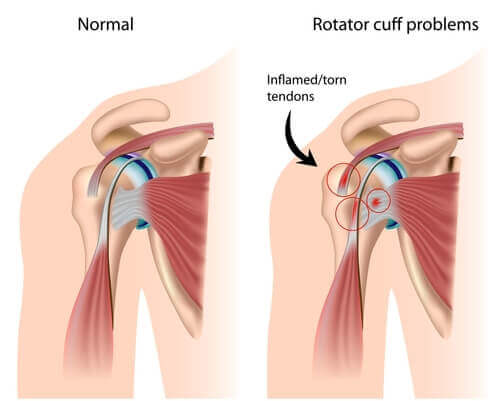
Cervical Radiculopathy
Shoulder pain that is a result of cervical radiculopathy does not originate from the shoulder. Cervical radiculopathy involves aggravation of one of the nerves that come from the cervical spine (your neck). The nerves that innervate your shoulder, arm, and hands originate from the spinal cord exiting through the intervertebral foramen (IVF) on either side of your neck.
Cervical radiculopathy is known as referred pain. When we have an injury in the structures of the cervical spine, this can either decrease the space of the IVF, leading to compression or irritation of the nerve or tight neck muscles may be the culprit.
Conditions That May Cause Cervical Radiculopathy:
- Bone Spurs
- Degenerated vertebra (Osteoarthritis)
- Cervical Disc Derangement (bulge, herniation, protrusion)
- Overactive muscles compressing the nerve
In the case of cervical radiculopathy, most likely the treatment will be focused on the structures of the neck. With this condition, it is common for the practitioner to not even work the shoulder area even though you may be feeling pain there.
Does Your Clinic Treat Shoulder Pain?
Absolutely! If you are experiencing shoulder pain, whether it is acute or chronic, call our clinic for an evaluation to determine the source of your issue and the appropriate treatment for it. When you are searching for ‘Chiropractor Edmonton’ or ‘Physiotherapy Edmonton’, our clinic should be at the top of your mind based on our proven track record for providing pain relief.
Whether the cause of the pain is coming from the shoulder or coming from the neck, our skilled practitioners will find the source of your pain. Proper treatment and time will provide relief from biomechanical-related shoulder pain.
At Enhanced Health & Wellness, we focus on helping you move and feel better and make sure you are receiving the appropriate care based on available evidence and clinical experience.
How Enhanced Health & Wellness Addresses Shoulder Pain
At Enhanced Health & Wellness, our goal is to provide an accurate diagnosis for your condition and determine the root of the problem. Using the many tools in our toolbox, we will create an appropriate treatment plan for the best recovery. Our chiropractor or physiotherapist can also provide recommendations on activity restriction and home care to treat your condition.
Our team believes that conservative care should always be the first form of care when it comes to neuromusculoskeletal (conditions involving the nerves, muscles, or skeletal system) issues.
Treatment options for shoulder pain may include:
- Chiropractic
- Physiotherapy
- Acupuncture
- Massage therapy
- Graston
- Laser therapy
- Sports rehabilitation
For severe cases and injuries, we may recommend you take some imaging (x-ray, US, MRI, etc.) and co-manage your condition with a specialist. If your condition is not something we can treat conservatively, we will recommend seeing an orthopedic surgeon. Our clinic makes every effort to ensure you get to the right place for your care and to feel better.
What to Expect During Your First Visit
Meeting your practitioner for the first time can be a little intimidating. At Enhanced Health & Wellness, we work with our patients to ensure they are as comfortable as possible.
At your first appointment, your practitioner will go over a thorough history to determine the cause and mechanism of your condition. Before an exam and treatment are performed, they will review your comfort levels and possible things that you are uncomfortable with. Learning your thoughts about your condition and goals for treatment will help guide the treatment plan.
After a detailed exam is performed, treatment is administered the same day and a customized treatment plan will be created. The treatment plan will include: treatment options, education and advice, and possibly home exercises to work on.

Don’t Live With Shoulder Pain
FAQ
Is surgery needed for shoulder pain?
In most cases of shoulder pain, including the conditions mentioned above, conservative care is the first form of treatment over surgery. Surgery should always be considered a last resort in most cases. If you have a complete tear of a ligament or muscle, then surgery would be the correct treatment over conservative care. Other incidences where surgery may be warranted is if there is a tear in the labrum of the glenohumeral joint.
How long does it take to get shoulder pain better?
The length of time needed to recover from shoulder pain will depend on a number of things. First off, the diagnosed shoulder condition will be a big factor in recovery speed. A frozen shoulder will take much longer and more treatments to decrease pain and restore function than a tendinitis.
Other factors that will affect recovery time include the body’s response to healing, ergonomics, lifestyle, and compliance to prescribed exercises.
When should I see someone for my pain?
If you or someone you know is experiencing any of the symptoms or conditions mentioned above, the Enhanced Health & Wellness team is here for you. Whether you are looking for an Edmonton chiropractor or Edmonton physiotherapist, our clinic offers both services. If you need a same-day examination and treatment for your injury, call our clinic at 780-431-1201 or you can book online.
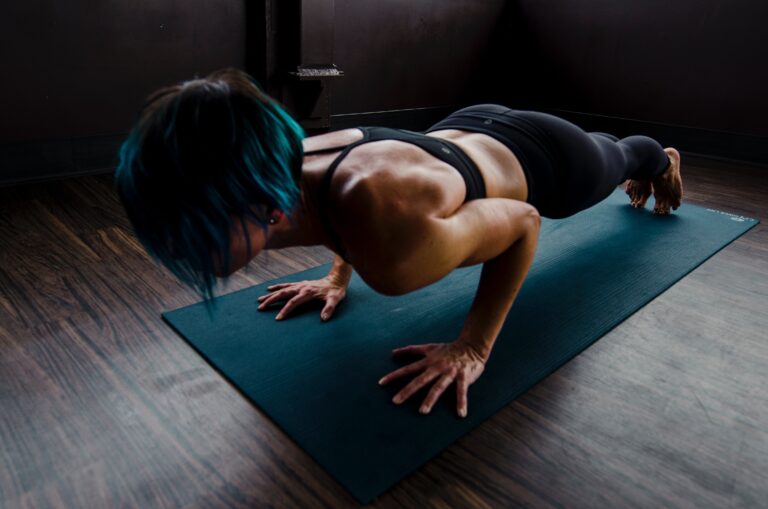
Many patients feel shoulder pain but expect it to go away if they wait long enough.
Although this may be true for some but if you have been experiencing shoulder pain for more than a few days, it is highly recommended you receive an assessment and treatment.
We use our arms and shoulders every day for various tasks. Once you lose range of motion in your shoulder, it becomes very difficult to function.
Decreased shoulder function can impact your life negatively whether it’s preventing you from playing with your kids, stopping you from playing the sport you enjoy, or trying to reach to scratch your back.
If you are experiencing shoulder pain, give us a call or book with us online and allow us to get you back to living your best life.

